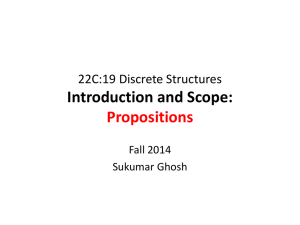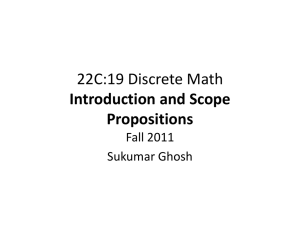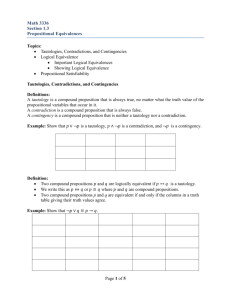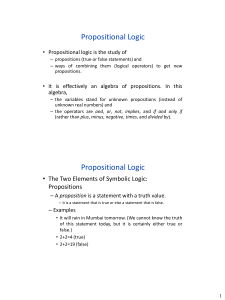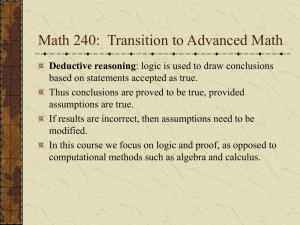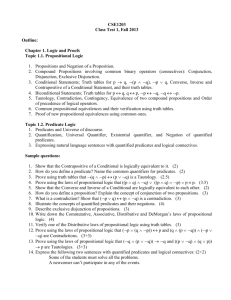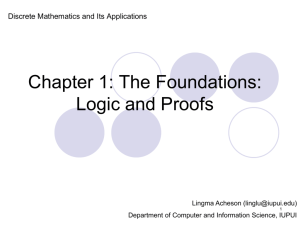Document
advertisement
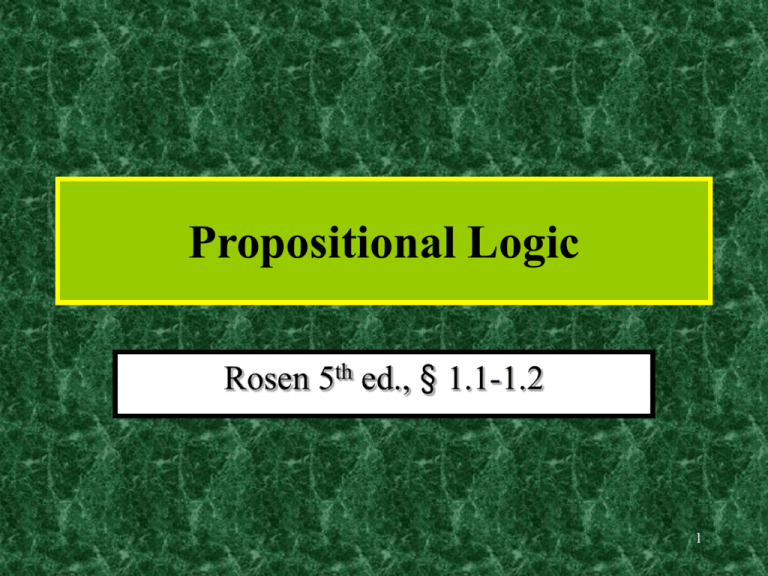
Propositional Logic Rosen 5th ed., § 1.1-1.2 1 Foundations of Logic: Overview • Propositional logic: – Basic definitions. – Equivalence rules & derivations. • Predicate logic – Predicates. – Quantified predicate expressions. – Equivalences & derivations. 2 Propositional Logic Propositional Logic is the logic of compound statements built from simpler statements using Boolean connectives. Applications: • Design of digital electronic circuits. • Expressing conditions in programs. • Queries to databases & search engines. 3 Definition of a Proposition A proposition (p, q, r, …) is simply a statement (i.e., a declarative sentence) with a definite meaning, having a truth value that’s either true (T) or false (F) (never both, neither, or somewhere in between). [In probability theory, we assign degrees of certainty to propositions. For now: True/False only!] 4 Examples of Propositions • “It is raining.” (Given a situation.) • “Beijing is the capital of China.” • “1 + 2 = 3” The following are NOT propositions: • “Who’s there?” (interrogative, question) • “La la la la la.” (meaningless interjection) • “Just do it!” (imperative, command) • “Yeah, I sorta dunno, whatever...” (vague) • “1 + 2” (expression with a non-true/false value) 5 Operators / Connectives An operator or connective combines one or more operand expressions into a larger expression. (E.g., “+” in numeric exprs.) Unary operators take 1 operand (e.g., -3); binary operators take 2 operands (eg 3 4). Propositional or Boolean operators operate on propositions or truth values instead of on numbers. 6 The Negation Operator The unary negation operator “¬” (NOT) transforms a prop. into its logical negation. E.g. If p = “I have brown hair.” then ¬p = “I do not have brown hair.” Truth table for NOT: p p T F F T 7 The Conjunction Operator The binary conjunction operator “” (AND) combines two propositions to form their logical conjunction. E.g. If p=“I will have salad for lunch.” and q=“I will have steak for dinner.”, then pq=“I will have salad for lunch and I will have steak for dinner.” 8 Conjunction Truth Table • Note that a p q pq conjunction F F F p1 p2 … pn F T F of n propositions T F F will have 2n rows in its truth table. T T T • ¬ and operations together are universal, i.e., sufficient to express any truth table! 9 The Disjunction Operator The binary disjunction operator “” (OR) combines two propositions to form their logical disjunction. p=“That car has a bad engine.” q=“That car has a bad carburetor.” pq=“Either that car has a bad engine, or that car has a bad carburetor.” 10 Disjunction Truth Table • Note that pq means p q pq that p is true, or q is F F F true, or both are true! F T T • So this operation is T F T also called inclusive or, T T T because it includes the possibility that both p and q are true. • “¬” and “” together are also universal. 11 A Simple Exercise Let p=“It rained last night”, q=“The sprinklers came on last night,” r=“The lawn was wet this morning.” Translate each of the following into English: ¬p = “It didn’t rain last night.” lawn was wet this morning, and r ¬p = “The it didn’t rain last night.” ¬ r p q = “Either the lawn wasn’t wet this morning, or it rained last night, or the sprinklers came on last night.” 12 The Exclusive Or Operator The binary exclusive-or operator “” (XOR) combines two propositions to form their logical “exclusive or” (exjunction?). p = “I will earn an A in this course,” q = “I will drop this course,” p q = “I will either earn an A for this course, or I will drop it (but not both!)” 13 Exclusive-Or Truth Table • Note that pq means p q pq that p is true, or q is F F F true, but not both! F T T • This operation is T F T called exclusive or, T T F because it excludes the possibility that both p and q are true. • “¬” and “” together are not universal. 14 Natural Language is Ambiguous Note that English “or” is by itself ambiguous regarding the “both” case! p q p or q “Pat is a singer or F F F Pat is a writer.” - F T T T F T “Pat is a man or T T undef. Pat is a woman.” - Need context to disambiguate the meaning! For this class, assume “or” means inclusive. 15 The Implication Operator The implication p q states that p implies q. It is FALSE only in the case that p is TRUE but q is FALSE. E.g., p=“I am elected.” q=“I will lower taxes.” p q = “If I am elected, then I will lower taxes” (else it could go either way) 16 Implication Truth Table • p q is false only when p q pq p is true but q is not true. F F T • p q does not imply F T T that p causes q! T F F • p q does not imply T T T that p or q are ever true! • E.g. “(1=0) pigs can fly” is TRUE! 17 Examples of Implications • “If this lecture ends, then the sun will rise tomorrow.” True or False? • “If Tuesday is a day of the week, then I am a penguin.” True or False? • “If 1+1=6, then George passed the exam.” True or False? • “If the moon is made of green cheese, then I am richer than Bill Gates.” True or False? 18 Inverse, Converse, Contrapositive Some terminology: • The inverse of p q is: ¬ p ¬q • The converse of p q is: q p. • The contrapositive of p q is: ¬q ¬ p. • One of these has the same meaning (same truth table) as p q. Can you figure out which? 19 How do we know for sure? Proving the equivalence of p q and its contrapositive using truth tables: p F F T T q F T F T q T F T F p T T F F pq q p T T T T F F T T 20 The biconditional operator The biconditional p q states that p is true if and only if (IFF) q is true. It is TRUE when both p q and q p are TRUE. p = “It is raining.” q = “The home team wins.” p q = “If and only if it is raining, the home team wins.” 21 Biconditional Truth Table • p q means that p and q have the same truth value. • Note this truth table is the exact opposite of ’s! p q means ¬(p q) p F F T T q pq F T T F F F T T • p q does not imply p and q are true, or cause each other. 22 Boolean Operations Summary • We have seen 1 unary operator (4 possible) and 5 binary operators (16 possible). p F F T T q F T F T p pq pq pq pq pq T F F F T T T F T T T F F F T T F F F T T F T T 23 Precedence of Logical Operators Operator Precedence ¬ 1 2 3 4 5 24 Nested Propositional Expressions • Use parentheses to group sub-expressions: “I just saw my old friend, and either he’s grown or I’ve shrunk.” = f (g s) – (f g) s would mean something different – f g s would be ambiguous • By convention, “¬” takes precedence over both “” and “”. – ¬s f means (¬s) f , not ¬ (s f) 25 Some Alternative Notations Name: Propositional logic: Boolean algebra: C/C++/Java (wordwise): C/C++/Java (bitwise): not and or p pq + ! && || ~ & | xor implies != ^ iff == Logic gates: 26 Tautologies and Contradictions A tautology is a compound proposition that is true no matter what the truth values of its atomic propositions are! Ex. p p [What is its truth table?] A contradiction is a comp. prop. that is false no matter what! Ex. p p [Truth table?] Other comp. props. are contingencies. 30 Propositional Equivalence Two syntactically (i.e., textually) different compound propositions may be semantically identical (i.e., have the same meaning). We call them equivalent. Learn: • Various equivalence rules or laws. • How to prove equivalences using symbolic derivations. 31 Proving Equivalences Compound propositions p and q are logically equivalent to each other IFF p and q contain the same truth values as each other in all rows of their truth tables. Compound proposition p is logically equivalent to compound proposition q, written pq, IFF the compound proposition pq is a tautology. 32 Proving Equivalence via Truth Tables Ex. Prove that pq (p q). p F F T T q F T F T pq F T T T p T T F F q p q (p q) T T F F F T T F T F F T 33 Equivalence Laws • These are similar to the arithmetic identities you may have learned in algebra, but for propositional equivalences instead. • They provide a pattern or template that can be used to match much more complicated propositions and to find equivalences for them. 34 Equivalence Laws - Examples • • • • • • Identity: pT p pF p Domination: pT T pF F Idempotent: pp p pp p Double negation: p p Commutative: pq qp pq qp Associative: (pq)r p(qr) (pq)r p(qr) 35 More Equivalence Laws • Distributive: p(qr) (pq)(pr) p(qr) (pq)(pr) • De Morgan’s: (pq) p q (pq) p q 36 More Equivalence Laws • Absorption: p(pq) p p (p q) p • Trivial tautology/contradiction: p p T p p F 37 Defining Operators via Equivalences Using equivalences, we can define operators in terms of other operators. • Implication: pq p q • Biconditional: pq (pq) (qp) pq (pq) • Exclusive or: pq (pq)(pq) pq (pq)(qp) 38 An Example Problem • Check using a symbolic derivation whether (p q) (p r) p q r. (p q) (p r) [Expand definition of ] (p q) (p r) [Defn. of ] (p q) ((p r) (p r)) [DeMorgan’s Law] (p q) ((p r) (p r)) 39 Example Continued... (p q) ((p r) (p r)) [ commutes] (q p) ((p r) (p r)) [ associative] q (p ((p r) (p r))) [distrib. over ] q (((p (p r)) (p (p r))) [assoc.] q (((p p) r) (p (p r))) [trivial taut.] q ((T r) (p (p r))) [domination] q (T (p (p r))) [identity] q (p (p r)) cont. 40 End of Long Example q (p (p r)) [DeMorgan’s] q (p (p r)) [Assoc.] q ((p p) r) [Idempotent] q (p r) [Assoc.] (q p) r [Commut.] p q r Q.E.D. (quod erat demonstrandum) 41
